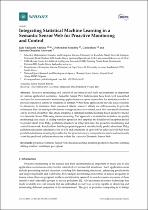 ResearchSpace
ResearchSpace
Integrating statistical machine learning in a semantic sensor web for proactive monitoring and control
JavaScript is disabled for your browser. Some features of this site may not work without it.
- ResearchSpace
- →
- Research Publications/Outputs
- →
- Journal Articles
- →
- View Item
| dc.contributor.author |
Adeleke, Jude Adekunle

|
|
| dc.contributor.author |
Moodley, Deshendran

|
|
| dc.contributor.author |
Rens, Gavin

|
|
| dc.contributor.author |
Adewumi, AO

|
|
| dc.date.accessioned | 2018-01-25T12:22:03Z | |
| dc.date.available | 2018-01-25T12:22:03Z | |
| dc.date.issued | 2017-04 | |
| dc.identifier.citation | Adeleke, J.A. et al. 2017. Integrating statistical machine learning in a semantic sensor web for proactive monitoring and control. Sensors, vol. 17(4): doi: 10.3390/s17040807 | en_US |
| dc.identifier.issn | 1424-8220 | |
| dc.identifier.uri | http://www.mdpi.com/1424-8220/17/4/807 | |
| dc.identifier.uri | doi: 10.3390/s17040807 | |
| dc.identifier.uri | http://hdl.handle.net/10204/9989 | |
| dc.description | Open access article published in Sensors, vol. 17(4): doi: 10.3390/s17040807 | en_US |
| dc.description.abstract | Proactive monitoring and control of our natural and built environments is important in various application scenarios. Semantic Sensor Web technologies have been well researched and used for environmental monitoring applications to expose sensor data for analysis in order to provide responsive actions in situations of interest. While these applications provide quick response to situations, to minimize their unwanted effects, research efforts are still necessary to provide techniques that can anticipate the future to support proactive control, such that unwanted situations can be averted altogether. This study integrates a statistical machine learning based predictive model in a Semantic Sensor Web using stream reasoning. The approach is evaluated in an indoor air quality monitoring case study. A sliding window approach that employs the Multilayer Perceptron model to predict short term PM 2 . 5 pollution situations is integrated into the proactive monitoring and control framework. Results show that the proposed approach can effectively predict short term PM 2 . 5 pollution situations: precision of up to 0.86 and sensitivity of up to 0.85 is achieved over half hour prediction horizons, making it possible for the system to warn occupants or even to autonomously avert the predicted pollution situations within the context of Semantic Sensor Web. | en_US |
| dc.language.iso | en | en_US |
| dc.publisher | MDPI AG | en_US |
| dc.relation.ispartofseries | Worklist;20138 | |
| dc.subject | Semantic sensor web | en_US |
| dc.subject | Machine learning | en_US |
| dc.subject | Multilayer perceptron | en_US |
| dc.subject | Proactive | en_US |
| dc.subject | Situation prediction | en_US |
| dc.subject | Sliding window | en_US |
| dc.subject | Stream reasoning | en_US |
| dc.title | Integrating statistical machine learning in a semantic sensor web for proactive monitoring and control | en_US |
| dc.type | Article | en_US |
| dc.identifier.apacitation | Adeleke, J. A., Moodley, D., Rens, G., & Adewumi, A. (2017). Integrating statistical machine learning in a semantic sensor web for proactive monitoring and control. http://hdl.handle.net/10204/9989 | en_ZA |
| dc.identifier.chicagocitation | Adeleke, Jude Adekunle, Deshendran Moodley, Gavin Rens, and AO Adewumi "Integrating statistical machine learning in a semantic sensor web for proactive monitoring and control." (2017) http://hdl.handle.net/10204/9989 | en_ZA |
| dc.identifier.vancouvercitation | Adeleke JA, Moodley D, Rens G, Adewumi A. Integrating statistical machine learning in a semantic sensor web for proactive monitoring and control. 2017; http://hdl.handle.net/10204/9989. | en_ZA |
| dc.identifier.ris | TY - Article AU - Adeleke, Jude Adekunle AU - Moodley, Deshendran AU - Rens, Gavin AU - Adewumi, AO AB - Proactive monitoring and control of our natural and built environments is important in various application scenarios. Semantic Sensor Web technologies have been well researched and used for environmental monitoring applications to expose sensor data for analysis in order to provide responsive actions in situations of interest. While these applications provide quick response to situations, to minimize their unwanted effects, research efforts are still necessary to provide techniques that can anticipate the future to support proactive control, such that unwanted situations can be averted altogether. This study integrates a statistical machine learning based predictive model in a Semantic Sensor Web using stream reasoning. The approach is evaluated in an indoor air quality monitoring case study. A sliding window approach that employs the Multilayer Perceptron model to predict short term PM 2 . 5 pollution situations is integrated into the proactive monitoring and control framework. Results show that the proposed approach can effectively predict short term PM 2 . 5 pollution situations: precision of up to 0.86 and sensitivity of up to 0.85 is achieved over half hour prediction horizons, making it possible for the system to warn occupants or even to autonomously avert the predicted pollution situations within the context of Semantic Sensor Web. DA - 2017-04 DB - ResearchSpace DP - CSIR KW - Semantic sensor web KW - Machine learning KW - Multilayer perceptron KW - Proactive KW - Situation prediction KW - Sliding window KW - Stream reasoning LK - https://researchspace.csir.co.za PY - 2017 SM - 1424-8220 T1 - Integrating statistical machine learning in a semantic sensor web for proactive monitoring and control TI - Integrating statistical machine learning in a semantic sensor web for proactive monitoring and control UR - http://hdl.handle.net/10204/9989 ER - | en_ZA |





